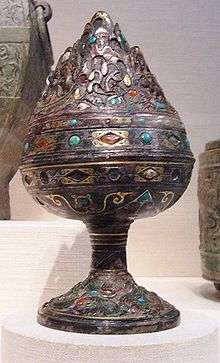Hill censer

The hill censer or boshanlu (博山爐 "universal mountain censer" or boshan xianglu 博山香爐) is a type of censer, a vessel used for burning incense. It was commonly used during the Han dynasty (206 BC – 220 AD).[1] The censers are shaped like mountains and were used for religious rituals. The shape of the hill censer acts as a visual aid for envisioning the sacred mountains that were said to have been inhabited by Taoist immortals.[2] Hill censers were originally designed for Taoist rituals, but were later used by Chinese Buddhists.[3] Ting Huan is credited with the invention of the hill censer in 180 BC. His censer was a "nine-storied" hill censer.[4]
Hill censers often include carvings of wilds animals and birds. Some censers depict waves at the foundation of the vessel, said to be the waves of the East China Sea.[5] A hole at the top of the censer releases the smoke of the incense.[5]
References
- ↑ boshan xianglu at Encyclopædia Britannica
- ↑ Kristofer Schipper (2000). Stephen Little; Shawn Eichman, eds. Taoism and the Arts of China. University of California Press. p. 37. ISBN 978-0-520-22785-9.
- ↑ Colin A. Ronan (20 June 1985). The Shorter Science and Civilisation in China. Cambridge University Press. p. 281. ISBN 978-0-521-31536-4.
- ↑ Silvio A. Bedini (1994). The Trail of Time. Cambridge University Press. p. 28. ISBN 978-0-521-37482-8.
- 1 2 Michael Sullivan. The Arts of China. University of California Press. p. 73. ISBN 978-0-520-04918-5.
External links
- Boshanlu- Detailed monograph with several examples